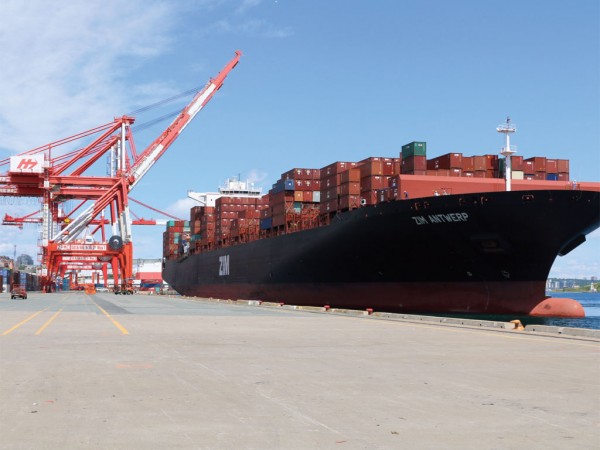Mention the Midwest, and it does not take long for key Canadian ports and terminal operators on the east and west coasts, along with various transportation providers, to rapidly target the region as a major strategic market in North America.
Indeed, for the Midwest, Canada is the leading trading partner. Bilateral trade between the 12 Midwest states led by Michigan and Canada approaches US$200 billion annually. And Canada accounts for more than one third of the Midwest’s international trade.
In the past few decades, the Port of Montreal has represented a significant gateway for Midwest import and export cargo, competing with such U.S. East Coast ports as New York and Baltimore. The Midwest generates roughly13% of the port’s total box throughput of 1.5 million TEUs. Regular customers have been such large Midwest shippers as Caterpillar, John Deere and Ford.

“The US Midwest market, has been historically a ‘battleground’ with plenty of rivals competing for discretionary cargo that moves in and out of the region. Admittedly, over the last few years the competition and challenges to service the US Midwest have intensified and the big cargo owners are now looking more at door-to-door logistic supply chain solutions. One thing is for sure, we are more than ever committed to playing our part to remain a reliable and predictable link in the supply chain.”
Halterm Sparking New Developments at Halifax
On the Atlantic Coast, the Port of Halifax is currently enjoying a strong comeback with larger vessels helping the Nova Scotia deep water port surge past half a million containers annually. The Midwest, thanks to a large degree to direct double-stack service by CN, is traditionally a key market.
Lane Farguson, Communications Advisor to the Halifax Port Authority, states in this regard that “reaching into manufacturing centers and areas of high population is important as those areas present opportunities for cargo growth and business development. We see the potential for growth along South East Asian routes, European routes, the Caribbean and New England States, as well as central and Midwest markets including Montreal, Toronto, Chicago and Detroit.”
With almost 70% of Canada’s population living in Eastern Canada, Halterm International Container Terminal in Nova Scotia, appears well positioned to connect South Asia and European cargo to the major Canadian market.
But as Kim Holtermand, Halterm’s CEO & managing director told the American Journal of Transportation: “Shippers are also looking for reliable and high-quality east coast services to the US Midwest. In this market, Halterm has capacity where other gateways are under pressure.
“Over the last three years we have re-oriented our efforts towards developing South Asia and Mediterranean markets, supporting Zim, Ocean Alliance, Melfi and Maersk Line products direct to (or from) Eastern Canada via Halterm,” Holtermand said.
“Our customers have embraced the opportunity to move cargo, including temperature-controlled units, directly from growth markets in Vietnam, Malaysia and Turkey, as well as from Singapore and Colombo hubs, through Halterm and directly to Chicago, Detroit and Indianapolis using Halterm’s on-dock rail.”
“As first port of call in North America, services using Halterm enjoy minimal deviation from great circle routes out of Europe and no nautical or navigational restrictions on arrival,” Holtermand continued. “Halterm is Eastern Canada’s only terminal with such capabilities and it has the connectivity to ensure that cargo aboard ‘Ultra’ vessels crossing the Atlantic can reach the widest range of coastal and inland markets. Beyond the 10,750TEU vessels handled weekly at the terminal, we look forward to seeing the 14,000TEU vessels and larger in the months and years to come.”
In 2018 Halterm bolstered its operations with three new Kone rubber-tired gantry cranes (RTGs), adding to a container yard that delivers street-to-street truck turnaround of less than 60 minutes and focuses on rail performance. “We have introduced a mentality of continuous improvement throughout the organization to ensure that our investments in equipment are matched by visible performance gains for our customer,” Holtermand adds. “By greater transparency both on our website and through the Port’s online Operations Centre, we are bringing the customer and our supply chain partners, like CN Rail, into the discussion. We are also adding a degree of accountability throughout our own organization.”
Halterm specializes in a range of services “where less is actually more,” Holtermand notes. “The fewer times we touch a container, the smaller the number of enquiries a customer must make to ensure required movement and the shorter the time a container is in our terminal, then the higher the customer’s perception of our service. Whether a client is transporting furniture from Ho Chi Minh to Detroit, or fresh live lobster from Atlantic Canada to the rest of the world, Halterm has grown the quality and range of its services by focusing on core service delivery and the company continues to grow at a fast pace.”
In the latest related important development, the Halifax Port Authority announced in late August a temporary pier extension at Halterm which will expand capacity at the South End Container Terminal so that it can accommodate two Ultra-Class vessels by 2020. The port indicated it was continuing to explore the option of expanding infrastructure at the terminal to the north under a long-term strategy.
Robust Trends on West Coast
On the West Coast, the ports of Vancouver and Prince Rupert are on track (see overview report on Canadian ports on page 16) for record throughputs this year. And Midwest cargo remains in the forefront especially at the Port of Prince Rupert in northern British Columbia where DP World operates an expanding container enterprise.
“Chicago remains the top destination for import containers from Asia,” said Brian Friesen, Prince Rupert’s director of trade development. “Toronto and Montreal are up there as is Memphis, a destination that has seen a lot of growth in the past few years. We are also seeing growth in Detroit and the Ohio valley. Much of that is driven by auto parts. On the way out, we are seeing agricultural products from the Midwest coming to Prince Rupert via the CN network which are then shipped to overseas markets.”
MSA’s Abbe Praises Role of Canadian Railways
In a recent interview Bruce Abbe, president and CEO of the Midwest Shippers Association, a regional agricultural grain export-focused trade association, praised the contribution of CP Rail and CN in moving Midwest agricultural products to West Coast ports as well as east to Europe and beyond via Montreal and Halifax.
In this regard, Abbe singled out the new CN Railroad and Duluth Cargo Connect intermodal container service that provides a fresh new option for shippers from Duluth/Superior. The Port of Vancouver’s efficient new on-dock rail service, Prince Rupert’s expansion of its container port – despite some service delays after roll-out – and reports of more double tracking in the works by the railways, are all positive investments that will benefit U.S. Midwest and Canadian shippers, Abbe said.

“Trucking and drayage costs are going to go up. It’s limiting that first leg of the global intermodal supply chains. We need to find a way to ease the constraints to getting ag freight to the rails, and then the ports. New options in smaller places like Duluth, where in and out service is done in minutes, may start to look more attractive to shippers compared to the logistics constraints of the big, dense yards.”





